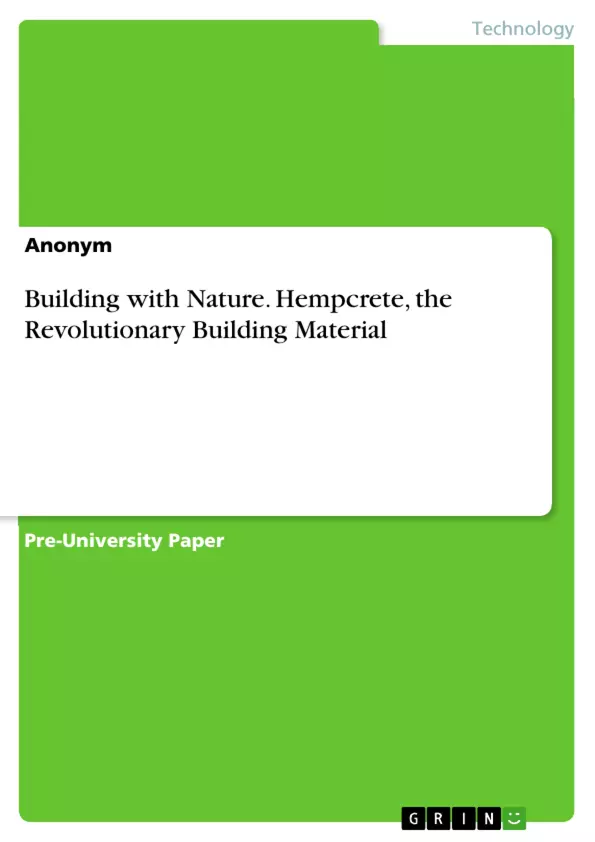The purpose of this research was to discover in what ways we could use hemp to benefit our society and the environment, as well as to gather more information on the latest invention “hempcrete” in construction industry. It has numerous beneficial aspects that other building materials do not possess. Another topic, which has to be discussed when doing research on anything hemp-related, is the prohibition of all sorts of cannabis since the early 1900s after a whole decamillennial of civilizations using hemp in innumerable ways in their everyday lives.
The writer of the following thesis gathered information on the detailed history of hemp, as well as the prohibition of the plant that began in the United States and is still active in some parts of the world today. Furthermore, she analyzed the possibilities of the once highly acknowledged plant being brought back into society, while mainly focusing on hemp as a building material.
On the one hand, this research paper is based on literature, and on the other hand, it contains a conducted interview with the organizer of the "WORLD HEMP CONGRESS", WORLD HEMP CONGRESS CEO., German architect and founder of the company “Cannabric” also provided the writer of this thesis with essential information on green building, using hemp. Cannabric is a company that is engaged in projects of ecological and bioclimatic architecture, restoration of historic buildings, and rehabilitation of traditional cave dwellings.
Inhaltsverzeichnis (Table of Contents)
- General information about Hemp and Cannabis.
- Definition
- The Plant
- History of the Plant
- China.
- India and the Middle East
- Africa....
- Europe
- Napoleon.....
- America and the Beginning of the Prohibition
- George Washington and Thomas Jefferson
- Henry Ford and the notorious Hemp car.
- Hemp as a Building Material
- Industrial Hemp...
- Hempcrete .....
- An introduction to lime
- Hempcrete varieties
- Examples of hempcrete homes
- Performance of Hempcrete in a Building
- Indoor Air Quality and Sick Building Syndrome......
- Legal and Political Issues
- The Future of Hempcrete.......
Zielsetzung und Themenschwerpunkte (Objectives and Key Themes)
This research paper explores the multifaceted potential of hemp, particularly its application as a sustainable and environmentally friendly building material. It aims to delve into the historical significance of hemp, its recent prohibition, and the possibilities of its reintroduction into society as a building material. The focus is on hempcrete, a revolutionary construction material with numerous advantages over conventional alternatives.
- Historical Significance of Hemp and its Prohibition
- Hempcrete as a Sustainable Building Material
- Environmental and Health Benefits of Hempcrete
- Legal and Political Challenges in Hemp Production and Use
- The Future Potential of Hempcrete in Building Construction
Zusammenfassung der Kapitel (Chapter Summaries)
The first chapter provides a comprehensive overview of hemp and cannabis, defining the plant and discussing its various varieties. It explores the historical usage of hemp, tracing its presence in ancient China, India, the Middle East, Africa, and Europe. The chapter then delves into the origins of the prohibition of hemp in the United States, highlighting the roles of individuals like George Washington, Thomas Jefferson, and Henry Ford.
Chapter three focuses on hemp as a building material, highlighting the growing demand for industrial hemp and the potential of hempcrete. It provides an in-depth analysis of hempcrete, explaining its composition, advantages, and various applications. It also explores the performance of hempcrete in buildings, particularly its impact on indoor air quality and its role in mitigating Sick Building Syndrome.
The fourth chapter investigates the legal and political challenges associated with hemp production and use. It examines the current legal landscape surrounding hemp and discusses the potential for future policy changes that could facilitate the wider adoption of hempcrete as a building material.
Schlüsselwörter (Keywords)
This research paper revolves around hemp, cannabis, industrial hemp, hempcrete, sustainable building materials, environmental benefits, indoor air quality, Sick Building Syndrome, prohibition, legal and political challenges, and the future potential of hempcrete.
- Citar trabajo
- Anonym (Autor), 2018, Building with Nature. Hempcrete, the Revolutionary Building Material, Múnich, GRIN Verlag, https://www.grin.com/document/961099



